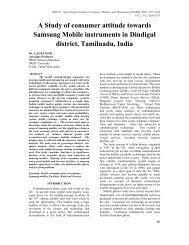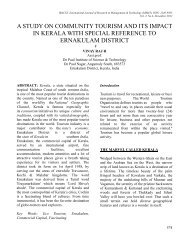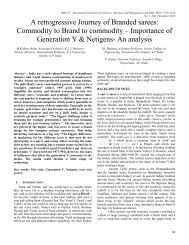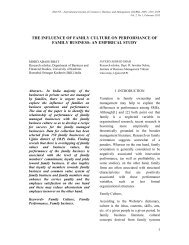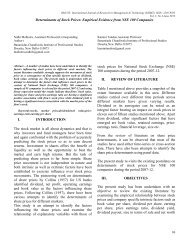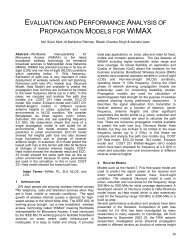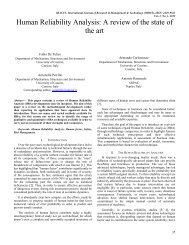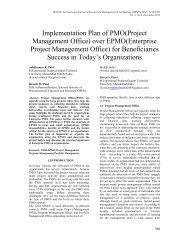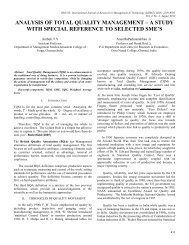Identifying Factors influencing preference towards Post Office ...
Identifying Factors influencing preference towards Post Office ...
Identifying Factors influencing preference towards Post Office ...
Create successful ePaper yourself
Turn your PDF publications into a flip-book with our unique Google optimized e-Paper software.
IRACST- International Journal of Research in Management & Technology (IJRMT), ISSN: 2249-9563<br />
Vol. 2, No.6, December 2012<br />
policy. Rests 15.3 percent of the respondents are<br />
interested to invest in post office in future period of<br />
time. Table 04 highlights the study of investment<br />
<strong>preference</strong> <strong>towards</strong> various schemes of Indian <strong>Post</strong><br />
<strong>Office</strong>. It reveals that 27.2 percent respondents are<br />
interested to invest in 5-year post office RD<br />
account. 13.5 percent prefer NSC investments. 13.1<br />
percent finds good to invest in post-office saving<br />
account. 12.2 percent prefer monthly income<br />
account and 12.0 percent prefer KVP investment.<br />
Only 11.4 percent prefer time deposit account as an<br />
investment avenue option. Rest 6.8 percent and 3.7<br />
percent prefer 15-year PPF account and senior<br />
citizens savings schemes respectively. The analysis<br />
on factors that motivates investors to invest in post<br />
office saving account is pointed out in table 05. It<br />
brings out that 39.8 percent prefer post office<br />
savings because of safe, secure and risk-free<br />
investment. 19.2 percent invest because of tax-free<br />
interest on savings in post-office. To avail the tax<br />
benefit under sec. 80(c) of Income Tax Act 13.6<br />
percent prefer post office savings. 11.3 percent of<br />
the respondents perceive post office schemes to<br />
have attractive rate of interest. 6.9 percent<br />
<strong>preference</strong> is because there is a facility of<br />
nomination in post office. Remaining 1.2 percent<br />
each prefer post office to save due to benefit of<br />
changing nomination at any time and instruments<br />
are transferable to any post office anywhere in<br />
India. Pravin Narayan Mahamuni, Santosh<br />
Kalabhau Apte and Dr. Anand Ganpatrao Jumle<br />
(2011) found that most of the respondents invest<br />
money for tax saving purpose. Mixed replies as laid<br />
out in table 06 about sources of investment advice<br />
shows that 41.4 percent are inclined more on their<br />
relatives and colleagues. 12.6 percent of the<br />
investors acquire knowledge from newspapers,<br />
12.1 percent from financial advisors and 10.8<br />
percent from media. The other 23.1 percent do not<br />
take help of the above sources of investment<br />
advice. These percentages of investors’ replies in<br />
questionnaire shows that they invest as per their<br />
self-acquainted knowledge or some invest under<br />
the guidance of agents. Analysis on criteria of<br />
selecting an agent in table 07 represents that 38.4<br />
percent of the respondents select agent on the basis<br />
of having personal relationship with the agent. 32.1<br />
percent look at the facilities offered by the agent.<br />
25.8 percent choose agent on his performance<br />
basis. Remaining investors look at other factors<br />
while selecting agent. Multiple response analysis<br />
indicated in table 08 represents that 20.8 percent<br />
respondents are investing their money for the<br />
purpose of acquiring an asset. 23.0 percent invest<br />
for child’s education. Next purpose is for<br />
retirement and old age which occupies 25.7 percent<br />
of the respondents. Child’s marriage accounts for<br />
12.3 percent of the total respondents. 18.1 percent<br />
reveals that respondents are investing for other<br />
purposes like for future safety, saving, emergency,<br />
business expansion, reduce tax burden, for<br />
grandchildren. Works on the factors that discourage<br />
investors to investing in postal schemes (shown in<br />
table 09) disclose the following interpretation: Out<br />
of total respondents, maximum of respondents<br />
(20.3 percent) reported that they are not aware of<br />
the schemes of post office. 14.3 percent of the<br />
respondents say that less advertisement is the<br />
reason for low awareness. 11.1 percent of the<br />
respondents feel that the schemes are less<br />
attractive. 11.5 percent face the problem of IT<br />
related services. Respondents having a belief that<br />
postal savings generate low returns comprise 9.0<br />
percent of the total replies. 10.5 percent experience<br />
that it provide late and improper services. Out of<br />
total responses 7.0 percent do not find agents to be<br />
relied upon. 6.5 percent find liquidity problem i.e.<br />
they think that postal savings cannot be easily<br />
converted into cash. Incompatible hospitality<br />
produces a negative impact on postal savings;<br />
however 8.3 percent respondents realize hospitality<br />
of post office to be incompatible. 0.6 percent of the<br />
replies believe no guarantee of money return. Very<br />
few (0.8 percent) find that as capital appreciation is<br />
low in postal savings; it demotivates them to save<br />
in post office. In NCAER Report (2011) it was<br />
found that inadequate financial resources is the<br />
most import reason for not investing in secondary<br />
markets by household followed by inadequate<br />
information and no skills.<br />
Null Hypothesis (H 01) : “An individual’s<br />
<strong>preference</strong> <strong>towards</strong> post office saving schemes is<br />
not related with educational qualification of the<br />
investors.”<br />
For 28 degree of freedom table value of chi-square<br />
at 5 percent level of significance is 41.337. While<br />
the calculated value (spot Table 10) is greater than<br />
table value, therefore null hypothesis is rejected.<br />
Thus, there is meaningful relationship between<br />
<strong>preference</strong> <strong>towards</strong> post office saving schemes and<br />
educational qualification of respondents.<br />
Null Hypothesis (H 02) : “An individual’s<br />
inclination in direction of post office saving<br />
schemes is not associated by means of livelihood<br />
of the investors.”<br />
For 35 degree of freedom critical table value of chisquare<br />
is 107.4185566. In view of the fact that<br />
calculated value (table number 11) is less than table<br />
value, thus, null hypothesis is accepted. So, it is<br />
concluded that occupation and <strong>preference</strong> <strong>towards</strong><br />
post-office savings schemes are not related.<br />
Null Hypothesis (H 03) : “<strong>Factors</strong> that motivate an<br />
individual to invest in the saving products of<br />
post office are not linked with educational<br />
qualification of the savers.”<br />
For 28 degree of freedom table value of Pearson’s<br />
chi-square test is at 5 percent level of significance<br />
is 41.337. As it can be seen from the table 12 that<br />
calculated value is greater than table value,<br />
consequently factors motivating investors to invest<br />
553



